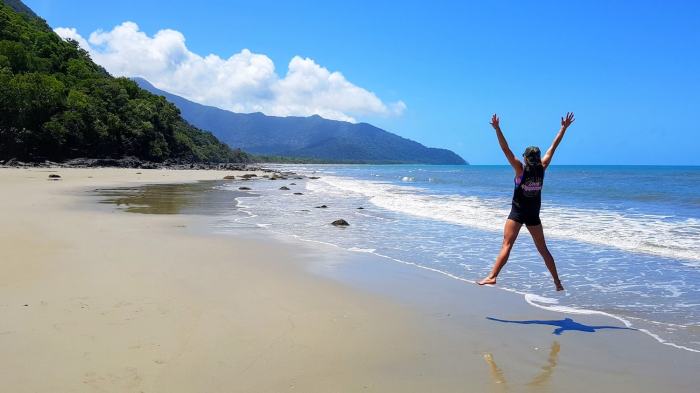
Eco-Friendly Adventure Travel sets the stage for this enthralling narrative, offering readers a glimpse into a story that is rich in detail and brimming with originality. From the significance of eco-friendly practices to the integration of cultural tourism, this topic delves into a world of sustainable exploration and cultural immersion.
As we explore the principles of eco-tourism, culinary experiences, historical travel, luxury options, budget-friendly tips, backpacking, solo adventures, and group activities, we uncover a tapestry of possibilities for eco-conscious travelers.
Introduction to Eco-Friendly Adventure Travel
Eco-friendly adventure travel refers to exploring natural environments and engaging in outdoor activities while minimizing negative impacts on the environment. It focuses on preserving and protecting the natural surroundings, wildlife, and local communities. This form of travel is essential in promoting sustainability and ensuring that future generations can also enjoy these destinations.
Sustainable Tourism in Adventure Travel
Sustainable tourism in adventure travel involves making conscious choices that benefit the environment, local communities, and wildlife. It aims to minimize the carbon footprint, support local economies, and preserve the cultural heritage of the destinations visited. By practicing sustainable tourism, travelers can contribute to the long-term conservation of these areas.
Impact of Eco-Friendly Practices on the Environment
- Reduction of carbon emissions through eco-friendly transportation options such as biking, hiking, or using electric vehicles.
- Conservation of natural resources by using eco-friendly accommodations that promote energy efficiency and reduce waste.
- Protection of wildlife habitats by following designated trails, respecting wildlife, and avoiding activities that disrupt their natural behavior.
- Promotion of local conservation efforts through responsible tourism practices and supporting initiatives that preserve biodiversity.
Cultural Tourism in Eco-Friendly Adventure Travel
When it comes to eco-friendly adventure travel, integrating cultural tourism is essential in creating a well-rounded and impactful experience. By immersing travelers in local cultures, they not only gain a deeper understanding of the destination but also contribute to the preservation of traditions and heritage.
Examples of Cultural Experiences
- Homestays with local families to learn about daily life and traditions firsthand.
- Participating in traditional ceremonies or festivals to witness the cultural richness of the community.
- Engaging in local crafts workshops to support artisans and learn about traditional craftsmanship.
- Exploring historical sites with knowledgeable local guides to understand the significance of the region’s heritage.
Respecting and Preserving Local Cultures
It is crucial to respect and preserve local cultures while traveling sustainably. By following these practices, travelers can ensure that their impact on the destination is positive and meaningful:
- Seeking permission before taking photographs of locals or cultural sites.
- Respecting dress codes and customs, such as covering up in religious sites or removing shoes before entering homes.
- Supporting local businesses and artisans by purchasing handmade souvenirs or products.
- Learning a few phrases in the local language to communicate with residents and show appreciation for their culture.
Eco-Tourism Principles and Practices
Eco-tourism is a form of sustainable travel that focuses on visiting natural areas to conserve the environment, respect local cultures, and contribute to the well-being of local communities. The core principles of eco-tourism include promoting conservation, minimizing impact, and empowering local communities.
Difference between Eco-Tourism and Traditional Tourism
- Eco-tourism focuses on sustainability and responsible travel practices, while traditional tourism often prioritizes mass tourism and profit without considering environmental and social impacts.
- Eco-tourism aims to educate travelers about the importance of conservation and cultural preservation, whereas traditional tourism may overlook these aspects.
- Eco-tourism promotes interaction with local communities and supports small-scale businesses, while traditional tourism may lead to exploitation and cultural commodification.
Role of Eco-Tourism in Conservation and Community Development
- Eco-tourism plays a crucial role in promoting conservation by raising awareness about environmental issues and supporting conservation efforts in natural habitats.
- By engaging local communities in eco-tourism activities, it helps in creating sustainable livelihoods and economic opportunities, contributing to community development.
- Eco-tourism encourages the preservation of cultural heritage and traditions, fostering a sense of pride and identity among local communities.
Culinary Experiences in Eco-Friendly Adventure Travel
Exploring local cuisines plays a significant role in eco-friendly adventure travel as it allows travelers to immerse themselves in the culture of the destinations they visit while supporting sustainable practices.
Local Cuisine Exploration
When travelers engage in culinary experiences during their eco-friendly adventures, they have the opportunity to taste traditional dishes made from locally sourced ingredients. By dining at local eateries and participating in cooking classes, they support the community and reduce their carbon footprint.
Connection Between Food, Culture, and Sustainability
Food is not only a means of sustenance but also a reflection of a region’s culture and traditions. By embracing local cuisines, travelers can gain a deeper understanding of the destination and its people. Additionally, choosing sustainable food options promotes environmentally friendly practices and helps preserve the natural resources of the area.
Historical Travel with a Sustainable Approach
When it comes to eco-friendly adventures, historical travel can offer a unique and enriching experience while also promoting sustainable practices. By exploring historical sites with a sustainable approach, travelers can learn about the past while contributing to the preservation of these important cultural landmarks.
Examples of Historical Sites in Sustainable Travel
- Machu Picchu in Peru: This ancient Incan city is not only a UNESCO World Heritage Site but also a great example of sustainable tourism. Measures such as visitor limits and strict waste management help preserve the site for future generations.
- Angkor Wat in Cambodia: One of the largest religious monuments in the world, Angkor Wat showcases a blend of history and sustainability. Conservation efforts and community involvement ensure the protection of this iconic site.
Historical Preservation and Sustainable Tourism
Historical preservation and sustainable tourism can work hand in hand to ensure the longevity of cultural heritage sites. By implementing eco-friendly practices such as waste reduction, energy conservation, and community engagement, historical sites can be protected for future generations to enjoy. Sustainable tourism also helps raise awareness about the importance of preserving our past and fosters a deeper appreciation for history and culture.
Luxury Eco-Friendly Travel Experiences

Luxury eco-friendly travel experiences have seen a significant rise in popularity in recent years as travelers become more conscious of their environmental impact. These high-end options offer a unique blend of luxurious accommodations and sustainable practices, providing a guilt-free way to indulge in luxury travel while minimizing carbon footprints.
Sustainable Luxury Accommodations
Luxury eco-friendly accommodations focus on incorporating sustainable practices into their operations, such as using renewable energy sources, minimizing waste, and supporting local communities. From eco-lodges nestled in the heart of nature to boutique hotels with green certifications, these establishments prioritize environmental conservation without compromising on comfort and luxury.
Demand for High-End Eco-Friendly Travel
Modern travelers are increasingly seeking luxury eco-friendly travel experiences, driven by a growing awareness of environmental issues and a desire to support sustainable practices. The demand for high-end eco-friendly travel options continues to rise as travelers prioritize experiences that not only offer luxurious amenities but also contribute positively to the environment and local communities.
Budget-Friendly Eco-Travel Tips
Traveling on a budget doesn’t mean you have to sacrifice your eco-friendly principles. With some smart planning and choices, you can embark on affordable eco-friendly adventures that are kind to the planet and your wallet.
Choose Off-Peak Seasons
Traveling during off-peak seasons can save you money on accommodations, transportation, and activities. It also helps reduce the environmental impact of your trip by avoiding overcrowded tourist destinations.
Pack Light and Smart
Opt for a lightweight, eco-friendly travel backpack and pack only the essentials to reduce carbon emissions during transportation. Bring reusable items like water bottles and shopping bags to minimize waste and expenses.
Use Public Transportation
Explore your destination using public transportation or eco-friendly modes of transport like biking or walking. Not only is this budget-friendly, but it also reduces your carbon footprint and supports local communities.
Stay in Eco-Friendly Accommodations
Look for budget-friendly eco-lodges, hostels, or guesthouses that prioritize sustainability. These accommodations often use renewable energy sources, reduce water consumption, and support local conservation efforts.
Eat Local and Seasonal
Save money and support the local economy by dining at restaurants that serve locally sourced, organic, and seasonal food. This not only reduces your carbon footprint but also provides an authentic culinary experience.
Backpacking and Sustainable Travel
Backpacking is a popular form of travel that aligns well with eco-friendly principles. It involves carrying all necessary belongings in a backpack, often relying on public transportation, walking, or biking to get around, thus reducing the carbon footprint associated with traditional forms of travel.
Benefits of Backpacking for Sustainable Exploration
- Minimizes carbon footprint: Backpackers typically use public transportation or walk, reducing the environmental impact of their travel.
- Engages with local communities: Backpackers often stay in hostels, guesthouses, or homestays, supporting local businesses and communities.
- Promotes conservation: Backpackers tend to be more mindful of their surroundings and are often more likely to participate in sustainable tourism activities.
Tips for Minimizing Environmental Impact while Backpacking
- Avoid single-use plastics: Bring a reusable water bottle and shopping bag to reduce waste.
- Choose eco-friendly accommodations: Look for hostels or guesthouses with green initiatives in place.
- Respect wildlife and nature: Stay on designated trails, avoid feeding wildlife, and take only pictures, leaving no trace behind.
- Use public transportation or walk: Reduce carbon emissions by opting for public transportation or walking whenever possible.
- Support local businesses: Eat at local restaurants, buy souvenirs from local artisans, and participate in community-based tours.
Solo Eco-Friendly Travel Experiences
Traveling solo can be a rewarding and enriching experience, especially when done in an eco-friendly manner. Solo eco-friendly travelers have the opportunity to immerse themselves in nature, cultures, and communities while minimizing their environmental impact. Here, we will explore the advantages of solo eco-friendly travel, how solo travelers can contribute to sustainability efforts, and provide safety tips for those embarking on solo eco-friendly adventures.
Advantages of Solo Eco-Friendly Travel
- Solo travelers have the flexibility to create their own itinerary and make spontaneous decisions that align with sustainable practices.
- Opportunity to connect more deeply with local communities and nature, fostering a greater sense of cultural understanding and appreciation.
- Enhanced personal growth and self-discovery through navigating unfamiliar environments independently.
Contributing to Sustainability Efforts
- Supporting local eco-friendly businesses and initiatives that prioritize conservation and community well-being.
- Practicing responsible travel habits such as reducing waste, conserving water, and respecting wildlife and natural habitats.
- Participating in volunteer programs or eco-friendly projects that aim to protect the environment and promote sustainable practices.
Safety Tips for Solo Eco-Friendly Travelers
- Inform a trusted person about your travel plans, itinerary, and expected return dates.
- Research the destination thoroughly, including local customs, emergency contacts, and potential risks.
- Stay connected with a reliable communication device and have emergency contacts saved for quick access.
- Trust your instincts and avoid risky situations or unfamiliar environments, especially when traveling alone.
- Pack essential items such as first aid kits, emergency supplies, and travel documents in a secure and accessible manner.
Group Eco-Friendly Travel Activities
Group travel can play a crucial role in promoting sustainable practices within the tourism industry. By traveling in groups, individuals can reduce their carbon footprint, share resources, and support local communities in a more impactful way. Here we will explore how group travelers can make a positive impact on local communities and the environment through eco-friendly activities.
Examples of Group Eco-Friendly Activities
- Organizing beach clean-ups to help preserve marine ecosystems and protect wildlife habitats.
- Participating in tree planting initiatives to combat deforestation and promote biodiversity.
- Supporting local conservation projects by volunteering for wildlife monitoring or habitat restoration efforts.
- Engaging in cultural exchange programs with indigenous communities to learn about their sustainable practices and support their livelihoods.
- Choosing eco-friendly accommodations that prioritize energy efficiency, waste reduction, and local sourcing.
Epilogue

In conclusion, Eco-Friendly Adventure Travel presents a holistic approach to sustainable exploration, emphasizing the importance of respecting local cultures, conserving the environment, and making conscious travel choices. Whether you’re a solo traveler seeking unique experiences or part of a group eager to make a positive impact, this eco-friendly journey offers something for everyone.
Questions Often Asked
How can eco-friendly practices benefit the environment?
Eco-friendly practices such as reducing waste, conserving energy, and supporting local communities can help minimize the negative impact of travel on the environment.
What are some examples of cultural experiences in eco-friendly trips?
Cultural experiences like visiting local markets, participating in traditional ceremonies, and learning about indigenous customs can enhance eco-friendly adventures.
Is luxury eco-friendly travel accessible to budget-conscious travelers?
There are increasingly affordable luxury eco-friendly travel options available, catering to travelers who seek sustainability without compromising comfort.





